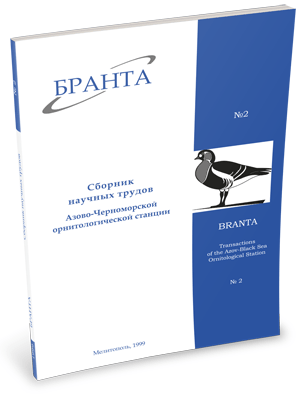
Transactions
of the Azov-Black Sea Ornithological Station



Numbers and phenology of Curlew Sandpiper migration in Ukraine
Diadicheva E.A., Khomenko S.V., Zmud M.H., Chernichko I.I., Garmash B.A., Kinda V.V.
All available published data on the numbers and phenology of migration in the inland as well as coastal areas of Ukraine were summarised in the paper. The original data were obtained from the database of the Azov-Black Sea Ornithological Station. This database system includes totals for the wetlands along the Azov-Black Sea coast, which were visited occasionally in 1986-1998, results of both regular and irregular counts in the Sivash area (1988-1998), catching data (1990 – 1998) and ringing recoveries. Most of the data were collected in the Sivash area situated in the north-eastern part of Crimea peninsula and the south of the Kherson region of Ukraine.
The Sivash was found to be the major stronghold of migratory Curlew Sandpipers in Ukraine. The available counting data suggest the minimum estimate of around 33,000 birds being simultaneously present in the area in spring. Taking into account that really observed maximum corresponds to the first peak of migration, high turnover rate, existence of the second migration peak and insufficient coverage of some Sivash wetlands by regular counts in spring, the total number of Curlew Sandpipers using the area in May can be doubled (66,000 birds). Most of birds (up to 95%) were counted in the saline lagoons of the Central Sivash.
A total count in mid August 1998 gave a figure about 72,500 birds, whereas calculations on the basis of 10 years’ observations suggest a maximum total of 113,300 birds which can be simultaneously present in the area. Taking into account later terms of female migration and proportion between the first and second peaks, real number of 110,000- 130,000 adults during autumn migration may be expected. As most juvenile Curlew Sandpiper are counted in the second half of August and September, at least 20,000-30,000 birds can be added according to irregular counting data available for this period. Although the whole Sivash is used by Curlew Sandpipers in autumn, majority of birds prefer the Central part of it.
Maximum totals obtained in spring in other coastal wetlands of the Azov-Sea coast can hardly add some 6,000-7,000 birds to the earlier mentioned estimate for the Sivash area. Everywhere along the coast Curlew Sandpipers are more numerous during autumn migration. A lower (compared to spring) water level enables presence of at least 10,000 birds in the limans and bays of the area in autumn. The largest concentrations are found in Tiligul (3,250 individuals) liman and some Azov limans (up to 5,000). Unfortunately, some limans of the Black Sea coast, especially in its north-eastern part, were not covered with counts. By our preliminary estimations about 8-9% of Curlew Sandpiper populations wintering in Africa and Mediterranean use the Sivash area in spring and about 15-21% in autumn.
Low numbers of Curlew Sandpipers in the inland regions of Ukraine, similar terms of migration at the inland and coastal sites and comparatively small autumn concentrations along the East Atlantic flyway suggest that the most part of birds fly across northern and central region of Ukraine non-stop following the Eastern route. After '‘refuelling ” and partly moulting in the Azov-Black Sea region they reach the African wintering grounds by the Mediterranean flyway. It seems that apart from the large numbers passing the Azov-Black Sea area, a portion of birds flies in a wide range across the continent both in spring and autumn and using river valleys and water reservoirs. There is an indication on the decrease of numbers in the inland areas related to the
regulation of Dnieper river in the 80s-90s. Significantly higher autumn numbers in comparison with spring confirm the existence of loop migration.
Two number peaks are recorded in the Sivash during spring (10-17.05 and 21-23.05) and three during autumn migration (7-8.08, 19-23.08 and about 11-12.09). According to the catching data in spring males pass the Sivash earlier than females. The males are likely to be among the first migrants in April and make the first wave of migration reaching maximum in the end of the first decade of May. Dependent on the year they can mix up with females, but mostly disappear by the mid May. From this time onwards females predominate in the catches and make the second wave of migrants in the second part of May.
The very first autumn migrants are recorded in the end of the first – beginning of the second decade of July in the same terms both in the continental and coastal Ukraine. Birds captured in the last decade of July in Tiligul liman were predominantly males. Proportion of females grows in the course of August, but the major portion arrives in mid August. Females are likely to leave the area in the middle – second half of September.
The first juvenile birds are sometimes captured already in the early August, but till the middle of the month their proportion in different years stays less than 10%. The major portion of them arrives together with females, but in the second part of September and later mostly juvenile birds are captured. The percentage of juveniles strongly varies by years clearly reflecting the breeding success in the previous season. Their proportion was high in 1991, 1993 (86-87 % in mid September), 1997 which were reported to be good breeding seasons in Arctic. Overall proportion of juveniles is quite high compared with coastal Europe.
Read the paper in a PDF file